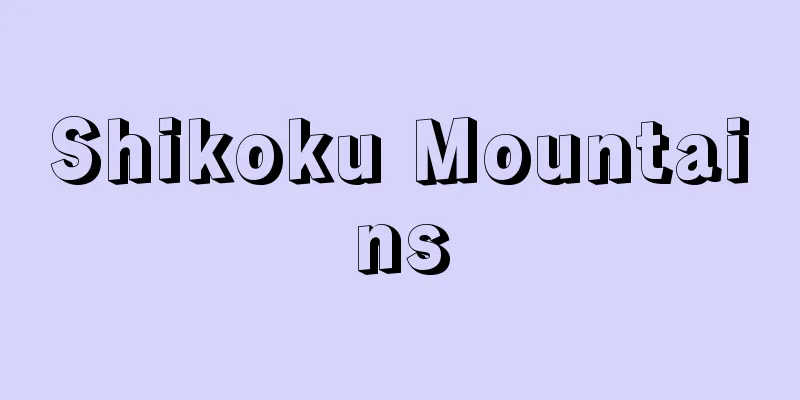Shikoku Mountains

|
A mountain range that runs 250 km from east to west through the center of Shikoku. It occupies the outer belt of the Median Tectonic Line, and has 13 mountains over 1000 meters high, with the highest being Mt. Ishizuchi (1982 meters), followed by Mt. Tsurugi (1955 meters). The southern side is the source of the Shimanto River, Niyodo River, and Monobe River, while the northeastern side is the source of the Yoshino River and Katsuura River. The mountain range is divided into thirds by the Niyodo River and the Yoshino River, with the central main water boundary being called the Ishizuchi Mountains and the eastern part being called the Tsurugi Mountains. Parallel to the south of the Tsurugi Mountains is the Kaifu Mountains, and Jinkichimori (1423 meters) is located there. The strike of each corresponds to the geological structure, with the extension of the Ishizuchi Mountains being the Sanbagawa Belt (crystalline schist), the Tsurugi Mountains being the Chichibu Belt (Paleozoic), and the Kaifu Mountains being the Shimanto Belt (Mesozoic). The Shikoku Mountains form the backbone of Shikoku, and the Pacific Ocean side, which faces typhoons and southeasterly seasonal winds, is a rainy area with an annual precipitation of 3,000 mm, while the Seto Inland Sea side is a backwind slope with rainfall of less than 1,000 mm. This uneven precipitation has led to the formation of forestry areas and power development areas such as Yanase and Kitou on the southern slope, and conversely, reservoir areas and mountain village farming areas on the northern slope. The steep topography also impedes north-south traffic, making mountain pass traffic an important route. The development of the mountainous areas was carried out by mountain samurai (local feudal lords since the Northern and Southern Dynasties) and others, and buckwheat, foxtail millet, konjac, paper mulberry and mitsumata were cultivated, and these are still handed down today as folk crafts such as washi paper and lacquerware. [Takagi Hideki] Source: Shogakukan Encyclopedia Nipponica About Encyclopedia Nipponica Information | Legend |
|
四国の中央部を東西に250キロメートルにわたって走る山地。中央構造線の外帯を占め、最高は石鎚山(いしづちさん)(1982メートル)、ついで剣山(つるぎさん)(1955メートル)で、1000メートル以上の山が13ある。南側は四万十(しまんと)川、仁淀(によど)川、物部(ものべ)川、北東側は吉野川と勝浦川などの水源をなす。山地は仁淀川と吉野川によって三分され、中央主水界を石鎚山脈、東部を剣山地という。剣山地の南に並行して海部山地(かいふさんち)が走り、甚吉森(じんきちもり)(1423メートル)がある。それぞれの走向は地質構造と一致し、石鎚山脈の延長は三波川(さんばがわ)帯(結晶片岩)、剣山地は秩父(ちちぶ)帯(古生層)、海部山地は四万十帯(中生層)になる。四国山地は四国の脊梁(せきりょう)をなし、台風や南東の季節風の向風斜面となる太平洋側では年降水量3000ミリメートルの多雨地帯となるが、瀬戸内海側は背風斜面で、雨量は1000ミリメートル以下である。この降水量の不均等性は、南斜面に魚梁瀬(やなせ)、木頭(きとう)の林業地帯や電源開発地帯を形成し、反対に北斜面は溜池(ためいけ)地帯や山村畑作地帯を形成した。また急峻(きゅうしゅん)な地形は南北の交通を妨げ、峠交通が重要な要路となってきた。山地の開発は山岳武士(南北朝以来の土豪)などにより進められ、ソバ、アワ、コンニャク、コウゾ、ミツマタの栽培が行われ、現在も和紙や塗り物などの民芸品として伝承されている。 [高木秀樹] 出典 小学館 日本大百科全書(ニッポニカ)日本大百科全書(ニッポニカ)について 情報 | 凡例 |
<<: Shikoku Transverse Expressway - Shikoku Transverse Expressway
Recommend
quarter-wave potential
…The time τ from the start of electrolysis to the...
East Asian Research Institute
A research institute for Japan's national poli...
Empain-Schneider
…A holding company that is the core company of Em...
Sub-concept - sub-concept
〘Noun〙 When two concepts have a relationship of su...
Uiroya - Uiro-ke
…When the Yuan Dynasty fell, the Chin family (kno...
Superheating
A state in which a liquid is heated to a temperatu...
Xiao Army
Chinese author. His real name was Liu Honglin. Xi...
Oimatsu Tenmasha Shrine
...The southern area is home to mountains over 10...
Omizutori - Water-drawing ceremony
Nara Todaiji Temple's Nigatsudo Hall Shuni-e S...
Sea bream in a pot
...These crossbars are called chouji, kobashiri, ...
Kyoken - Kyoken
North Korean politician. Born in Myeongcheon, Nor...
Ciconia ciconia (English spelling) Ciconiaciconia
… [Yukio Taniguchi]. … *Some of the terminology t...
Mudra
...Since then, the 20th Century Ballet has create...
Tatsuo Amano
1892-1974 A nationalist from the Taisho to Showa ...
Naniwateikomakichi - Naniwateikomakichi
A rakugo performer. His real name was Sakurai Kom...





![Requinto (English spelling) [Spain]](/upload/images/67cd340c2a2cc.webp)



